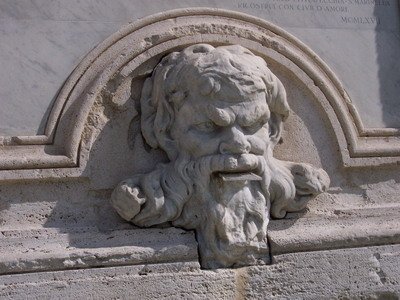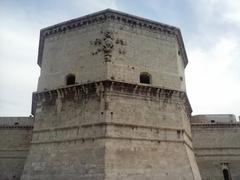
Visiting Fontana del Vanvitelli in Civitavecchia: Hours, Tickets, and Tips
Date: 01/08/2024
Introduction
Located in the picturesque port city of Civitavecchia, Italy, the Fontana del Vanvitelli stands as a testament to the grandeur of 18th-century Baroque architecture and the city’s rich maritime heritage. Designed by the illustrious architect Luigi Vanvitelli, best known for his work on the Royal Palace of Caserta, the fountain was commissioned by Pope Benedict XIV and completed in 1743. It was part of a broader urban development initiative aimed at both beautifying and modernizing Civitavecchia, a crucial Mediterranean port (Port Mobility Civitavecchia).
The Fontana del Vanvitelli is not merely an architectural marvel but also a significant cultural artifact. Featuring a central statue of Neptune, symbolizing the city’s deep connection to the sea, the fountain has been a focal point for local festivals, public gatherings, and cultural events throughout its history. Its intricate design, using travertine stone, reflects the elaborate and dramatic style characteristic of Baroque art (Wikipedia).
This comprehensive guide aims to provide you with all the essential information for visiting this iconic monument, including its historical background, visitor tips, nearby attractions, and more. Whether you are a history enthusiast, an architecture aficionado, or simply a traveler looking to explore the hidden gems of Italy, the Fontana del Vanvitelli offers a unique and enriching experience.
Table of Contents
- Introduction
- Historical Background
- Visitor Information
- Restoration Efforts
- Cultural Impact
- Visitor Experience
- FAQs
- Conclusion
Historical Background
Origins and Construction
The Fontana del Vanvitelli was designed by the renowned architect Luigi Vanvitelli, famous for his work on the Royal Palace of Caserta. Commissioned by Pope Benedict XIV, the construction began in 1740 and was completed in 1743. The fountain was part of a broader initiative to enhance the infrastructure and aesthetic appeal of Civitavecchia, a key port city on the Tyrrhenian Sea (Port Mobility Civitavecchia).
Architectural Significance
The fountain epitomizes Baroque architecture with its grandeur, intricate details, and dramatic use of space and water. Featuring a large central basin and smaller cascading basins, it uses travertine stone—a material commonly employed in Roman architecture. The central figure is a statue of Neptune, symbolizing Civitavecchia’s maritime heritage (Wikipedia).
Historical Context
During the 18th century, Civitavecchia was a bustling port city, essential for trade and travel across the Mediterranean. The Fontana del Vanvitelli was part of an urban development plan aimed at modernizing the city. It served both as a water source and a symbol of the city’s prosperity and cultural heritage (Port Mobility Civitavecchia).
Visitor Information
Visiting Hours and Tickets
The Fontana del Vanvitelli is accessible to the public 24/7, and there is no admission fee. However, guided tours may have specific hours and associated costs. Check the official Civitavecchia tourism website for up-to-date information.
Travel Tips
- Best Time to Visit: Early morning or late afternoon to avoid the crowd and capture the best light for photography.
- Nearby Attractions: The Civitavecchia Port, Forte Michelangelo, and the National Archaeological Museum.
- Accessibility: The site is wheelchair accessible, and there are several cafes and restaurants nearby for a relaxing visit.
Restoration Efforts
Over the centuries, the Fontana del Vanvitelli has undergone several restoration projects. The most recent restoration in 2020 involved cleaning the travertine stone, repairing damaged sections, and installing modern water circulation systems to ensure its functionality (Port Mobility Civitavecchia).
Cultural Impact
Historical Anecdotes
In 1857, Pope Pius IX visited the fountain and was so impressed by its design that he ordered similar fountains to be constructed in other parts of the Papal States. This anecdote highlights the fountain’s influence and its high regard among contemporary authorities (Wikipedia).
Influence on Modern Architecture
Luigi Vanvitelli’s design principles in the Fontana del Vanvitelli have had a lasting impact on modern architectural practices. The use of water, integration of sculpture and architecture, and the creation of visually dynamic spaces continue to inspire contemporary architects (Port Mobility Civitavecchia).
Visitor Experience
The Fontana del Vanvitelli is a must-visit for tourists exploring Civitavecchia. Informational plaques and guided narratives provide insights into its historical and cultural significance. The surrounding area, with cafes and restaurants, offers a perfect setting to relax and soak in the historical ambiance.
Preservation Challenges
Despite successful restoration efforts, the fountain faces ongoing challenges such as pollution and weathering. High foot traffic necessitates regular maintenance. Local authorities are actively working to address these issues through continuous monitoring and conservation initiatives (Port Mobility Civitavecchia).
Future Prospects
Plans are underway to enhance the visitor experience with augmented reality (AR) technology, allowing tourists to visualize the fountain’s historical context and construction process. These innovative approaches aim to make its rich history more accessible and engaging for future generations (Port Mobility Civitavecchia).
FAQs
What are the visiting hours for Fontana del Vanvitelli? The fountain is accessible 24/7.
Is there an admission fee? No, visiting the fountain is free.
Are there guided tours available? Yes, guided tours are available and may have specific hours and fees.
Is the fountain wheelchair accessible? Yes, the site is wheelchair accessible.
For more detailed information, you can visit the official Civitavecchia tourism website.
Conclusion
A visit to Fontana del Vanvitelli in Civitavecchia is more than just a sightseeing trip; it is an immersive journey through history, art, and culture. The fountain stands not only as a stunning example of 18th-century Baroque architecture but also as a symbol of Civitavecchia’s rich maritime heritage and urban development. Over the centuries, it has witnessed numerous historical events, from the bustling trade activities of the 18th century to modern-day cultural festivals and public gatherings (Port Mobility Civitavecchia).
The ongoing restoration efforts and plans for future enhancements, such as augmented reality experiences, underscore the community’s dedication to preserving this historical landmark for future generations. Whether you are drawn by its architectural beauty, historical significance, or cultural impact, the Fontana del Vanvitelli offers an unforgettable experience that enriches your understanding of Italy’s rich heritage. Don’t miss the opportunity to explore this iconic fountain and the surrounding attractions in Civitavecchia, and make sure to stay updated with the latest developments via the official tourism website and local tour operators (Port Mobility Civitavecchia).
References
- Port Mobility Civitavecchia, Fontana del Vanvitelli source url
- Wikipedia, Fontana del Vanvitelli source url





